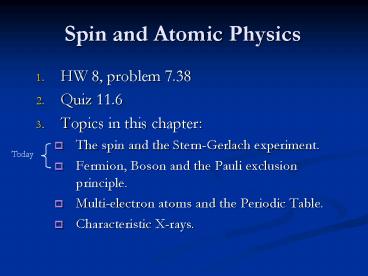Spin and Atomic Physics - PowerPoint PPT Presentation
1 / 13
Title:
Spin and Atomic Physics
Description:
Since it is an attractive central force and the angular momentum is given: ... Empirical formula in 1885: The de Broglie wave (1924): 1885. 1897. 1909. 1913 ... – PowerPoint PPT presentation
Number of Views:99
Avg rating:3.0/5.0
Title: Spin and Atomic Physics
1
Spin and Atomic Physics
- HW 8, problem 7.38
- Quiz 11.6
- Topics in this chapter
- The spin and the Stern-Gerlach experiment.
- Fermion, Boson and the Pauli exclusion principle.
- Multi-electron atoms and the Periodic Table.
- Characteristic X-rays.
Today
2
HW problem 7.38
Since it is an attractive central force and the
angular momentum is given
?
?
?
?
3
The Stern-Gerlach experiment in the history of QM
The Balmer series
656 nm
410 nm
434 nm
486 nm
1885
Empirical formula in 1885
Electron discovered in by J.J. Thomson in 1897
1897
Rutherford discovered nucleus in 1909
1909
1913
Niels Bohrs Hydrogen model in 1913
Stern-Gerlach experiment, electron spin in 1922
1922
The de Broglie wave (1924)
The Schrödinger Equation (1926)
1924
1926
4
The Stern-Gerlach experiment
Interesting to read http//scitation.aip.org/jou
rnals/doc/PHTOAD-ft/vol_56/iss_12/53_1.shtml
5
The Stern-Gerlach experiment
Classical
Quantum
observed
WOW !
6
The Stern-Gerlach experiment
Quantum
But
From
When ground state
But this was observed
WOW !!! What is this?
7
Spin, an intrinsic property
Spin an intrinsic magnetic dipole moment of
particles like electron, proton and photons. This
dipole moment is related to an intrinsic angular
momentum. The symbol is S, which is like L the
orbital angular momentum. The corresponding
quantum number is s. The spin magnetic
dipole moment is Spin is an intrinsic
property of a particle like mass and charge.
Example 8.1
electron
8
Fermions and Bosons
Spin is an intrinsic property of a particle like
mass and charge.
Fermions Bosons (half-integral
spin) (integral spin) Particle s Particle s
Electron, e- ½ Pion, p 0 0 Proton,
p ½ Alpha 0 Neutron, n ½ Photon,
? 1 Neutrino, ? ½ Deuteron, d 1 Omega,
O- ½ Graviton 2
9
The building blocks for our Universe
Spin is an intrinsic property of a particle like
mass and charge.
10
The Pauli exclusion principle
The Pauli exclusion principle (1924) No two
indistinguishable fermions may occupy the same
individual particle state. This principle
applies only to fermions in In an atom, or an
isolated system like a molecule. This principle
does not apply to bosons.
11
Review questions
- What is the spin of a particle in CM and in QM?
- Give one example in each the Pauli exclusion
principle is applied.
12
Preview for the next class (11/11)
- Text to be read
- 8.4 and 8.5
- Questions
- Why we have H2 as hydrogen molecules while Ne as
neon molecules? - What is the energy ordering of electron states in
an atom with Z 30? Can you fill the electrons
for the element Zn if asked for?
13
Homework 12, due by 11/13
- Problems 8.28, 8.31 on page 339.
- Read section 8.2 and 8.3 one more time and see if
you can answer questions in problem 8.7 on page
338.

